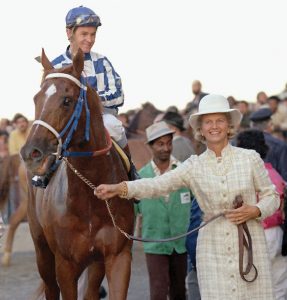On pace to become one of the greatest jockeys of all time, his career was cut short in a tragic accident on the track that left him paralyzed from the waist down, but Turcotte persevered and for over thirty years his winning ways continued off the track – in business, with his family, and in life.
Secretariat and the Knight Who Raced Him to Victory
Since returning home to New Brunswick four decades ago, Turcotte has kept himself busy. He has ranched beef cattle and raised other animals, and he has planted nearly 300,000 trees. After his four daughters graduated, he began making appearances at racetracks throughout Canada and the United States, signing autographs for charity. He serves on the board of the directors of the Permanently Disabled Jockeys Fund and offers encouragement to injured riders. Turcotte still travels occasionally, but is otherwise enjoying life in Drummond, where he lives with his wife of 52 years, Gaëtane, and continues to participate in his local K of C council.
An interview with Ron Turcotte, the Hall of Fame jockey

COLUMBIA: After your tragic accident in 1978, what role did your faith and family play in helping you through?
TURCOTTE: Well, I left my life in God’s hands and just kept taking it one day at a time. My wife was with me all the time at the hospital and just about lost me a couple times. I contracted meningitis, went into a coma and they had to re-operate.
I was told by the doctor that I would never walk again, and I just tried to do the most I could in my situation. My family was so great. They treated me the same as when I was riding, as the same person. I couldn’t ask for a better family, and I can’t say enough about my wife. She really helped me and stuck by me.
My family was so great. They treated me the same as when I was riding, as the same person. I couldn’t ask for a better family, and I can’t say enough about my wife. She really helped me and stuck by me.
Being a jockey is a very dangerous profession, but that’s something that never entered our minds. If we thought about how dangerous it was, then we probably wouldn’t do it — but you’re young, you’re fearless.
Still, I always kept a St. Christopher medal in my car and a small crucifix in my helmet.
It was a horse race like none other. In June 1973, a 3-year-old chestnut colt named Secretariat was poised to be the first winner of the illustrious Triple Crown of Thoroughbred Racing in 25 years. Secretariat, known affectionately as “Big Red,” had won the Kentucky Derby and Preakness Stakes in dramatic fashion the previous month. The horse captured the world’s attention, surpassing the Vietnam War, Roe v. Wade and the Watergate scandal in headlines. Still, few could imagine how stunning the win at the 1973 Belmont Stakes would be, with a speed and margin of victory that remain unmatched.
This past fall, Secretariat’s owner, Penny Chenery, died at age 95. The horse lived to be 19 years old, before dying in 1989, and the trainer, Lucien Laurin, died in 2000. The jockey who rode Secretariat to victory 45 years ago, however, is still alive and well, and he is a 51-year member of the Knights of Columbus.
Ron Turcotte, 76, is a member of St. Michael de Drummond Council 6841 in Drummond, New Brunswick. Five years after winning the Triple Crown, he was thrown from a horse on the Belmont track and suffered major injuries, ending his career and leaving him paralyzed from the waist down. But it didn’t change his outlook on life.
In anticipation of this year’s Triple Crown races, Columbia’s editor, Alton Pelowski, spoke with Turcotte about his career and his memories of riding the “greatest horse that ever lived.”

COLUMBIA: What led you to become a jockey?
RON TURCOTTE: I grew up here in New Brunswick in a family of 12 children. When I was old enough, I went to work with my dad cutting lumber. After about five years, my brother went to Toronto and made a lot more money roofing houses. I decided to go back with him to Toronto, but when we arrived, the carpenters were on strike. We left here with very little money in our pockets, and we ran out not long after we got there.
At the suggestion of my landlord, I looked for work at Woodbine Racetrack outside of Toronto. I tried twice to get in, but I couldn’t get by the gate without a pass.
Meanwhile, we found a restaurant that would feed us at night if we showed up at 5 and stayed until 9 to wash dishes. Then, we’d run to a bait company, hop in a truck and go pick worms and nightcrawlers until 2 or 3 in the morning. That’s how we paid for our room that first month.
The third time I headed to Woodbine I hitchhiked, and it happened to be a horse trainer who gave me the ride. We headed by the guards, and he dropped me off at the office of a man who helped me find a job at E.P. Taylor’s Windfields Farm, which had a horse that year in the 1960 Derby.
Not long after that, I became a jockey, even though I didn’t know anything about racing. Up until then, I didn’t even know what a jockey was.
COLUMBIA: And yet you went on to have an extremely successful career, beginning in Canada and then in the United States. Tell me about that.
TURCOTTE: Yes, I was leading rider the first year I rode in Canada. By October of the next year, I was 100 wins in front of the second rider.
There was a trainer at that time who wanted me to go to Maryland with him and finish out the year there. I was able to get out of my contract, and I became the leading rider in Maryland and also in Delaware the following spring, in 1964. That’s where I got to meet a lot of New York people. One of the stewards asked me where I was heading next. He told me, “You can ride with anybody. You’re pretty polished,” and encouraged me to go to New York.
There was a state race at the Aqueduct. I went there to ride a horse for Mr. William du Pont, and I won. A couple of days later, I was one of the first three riders at Saratoga.
COLUMBIA: In 1972, a year before you rode Secretariat in the Triple Crown, you rode another Triple Crown-contending horse from the same farm.
TURCOTTE: Well, Riva Ridge was actually the horse that saved the farm. I know the movie (Secretariat) doesn’t say that, but Riva Ridge was the winningest 2-year-old champion of 1971 and the favorite for the following year’s Kentucky Derby.
We won the Derby with him, and if it weren’t a muddy day at the Preakness, we would have gone on to win the Triple Crown. On the fast track, there was no 3-year-old that could beat him.
As for Secretariat, I first met him in Florida, and the trainer, Lucien Laurin, asked me to get on him and tell him what I thought. Oh, he was a very kind horse. He wasn’t flighty and timid like Riva Ridge.
COLUMBIA: What was it like to ride Secretariat?
TURCOTTE: It was really a dream come true. He was a professional horse; a very smart horse; a generous horse; gentle; he learned very fast. I can’t say enough good things about him, besides his ability to run. He was a really, really nice horse. He had ability, and he was the greatest horse I’ve ever seen.
What really impressed me was how tough a horse he was, how strong he was. He could take training like no other horse could take. The faster you worked him, the faster he’d run his races. When he was right, there was no horse that could beat him.
I already had a Hall of Fame career up to that time and had ridden a lot of great horses — more than I can remember. But Secretariat was the frosting on the cake.
There was a man, Hollie Hughes, who had trained the winner of the 1916 Kentucky Derby, so he had seen Man o’ War, which everybody claimed to be the greatest horse up to that time.
And he told me — this is before the Belmont — “Son, you’re riding the greatest horse that ever lived.” And he said, “Believe me, I know. I’ve seen them all. Man o’ War has nothing over this horse.” Finally, he said, “Don’t fall off.”
COLUMBIA: Secretariat would often break out of the gate last and come from behind, as in the 1973 Kentucky Derby. Why was that?
TURCOTTE: He was big and heavy, like an overgrown kid, so he needed a little time to get his legs together, his feet under him. And I’d give him the time, because I knew he could pick it up. I started schooling him that way, so he could go to the lead or I could come from behind and go between horses.
At the same time, he was a very versatile horse. I had won the Gotham Stakes on the lead with him.
I rode him the way I did in the Kentucky Derby because I didn’t think he was quite tight enough to go a mile and a quarter without a good race in the Wood Memorial a couple weeks earlier. He had a great big abscess under his upper lip and got beat there.
So, at the Derby, I just took it very easy with him the first quarter of a mile and then I start picking up my horses.
COLUMBIA: At the Derby, you ended up with a track record, which stands to this day. And the same goes for the next two races of the Triple Crown. Take us through those races.
TURCOTTE: Well, when we came to the Preakness, which is the second leg of the Triple Crown, I think that was the most beautiful of the races that I rode. I just passed everybody around the first turn and took control of the race at the three-quarter pole. We won very easily and broke the track record, even though it took nearly 40 years before they corrected the time and gave it to us.
When we came to the Belmont, I trained Secretariat very hard. I kept encouraging Lucien to let me go ahead with him, and he was afraid that I was doing too much with him. We kept going back and forth until I kind of won my point, because the horse was getting stronger and stronger all the time.
Anything can happen in a race, but I was so certain that we were going to see something extraordinary. I told Lucien that if I got beat in that race, I was going to hang my tag and quit riding. And he was so sure that he said he would quit training.
When I came out the gate in the Belmont, I just took it easy, letting him get his feet under him. But when I saw them closing ahead of me, I didn’t want to be trapped. So, I let him get to the lead, and I had control of the race. Then, I let him run to show everybody what he could do. I was kind of peeved that they didn’t give us a record at the Preakness, so I just let him run. We won by 31 lengths and took 2 and 3/5 seconds off the track record.
COLUMBIA: You were already a member of the Knights of Columbus by this time. What inspired you to join in 1967, and what has been your experience with the Order?
TURCOTTE: Well, I had a friend I went to school with. At that time, we sat two to a bench. By the time I came to New York, he was living in Connecticut. He was a member of the Knights of Columbus and asked if I wanted to join. I said, “Sure, I’d love to.” So, after the races one night, I took my First Degree in Bridgeport with the New Haven team there. I joined a council on Long Island and soon became a Third Degree member.
I’ve always enjoyed being a Knight, and I used to attend a lot of meetings when I lived in New York. When I came here, I transferred to St. Andre Council (7222) and then St. Michael Council (6841) in Drummond, where I’m a member now.
Secretariat History’s Greatest Horse
The record achievements of Secretariat, the chestnut colt ridden by Ron Turcotte during the 1973 U.S. Thoroughbred Triple Crown, remain unmatched to this day.
Named Horse of the Year in 1972 (the first 2-year-old to be so honored) and again in 1973.
• Won the 1973 Kentucky Derby in a record 1:59.40, becoming the first horse to complete the course in less than 2 minutes. • Broke another record at the Preakness Stakes two weeks later, finishing in 1:53 flat.
• Featured on the covers of Sports Illustrated, Time and Newsweek the week before the Belmont Stakes.
• Defeated the field at Belmont by a jaw-dropping 31 lengths with a record time of 2:24 for 1.5 miles.
• Inducted into the National Museum of Racing and Hall of Fame in 1974, and received numerous honors and distinctions since.
• Had a heart weighing approximately 22 pounds, more than twice the size of that of an average horse, as revealed by a necropsy in 1989.
A Knight at the Races
Below are career highlights of acclaimed jockey Ron Turcotte, a native of New Brunswick, Canada, and a member of the Knights of Columbus since 1967.
• Rode more than 3,000 winners during his 18-year career.
• Won the Preakness Stakes aboard Tom Rolfe in 1965, and the Kentucky Derby and the Belmont Stakes aboard Riva Ridge in 1972.
• Rode Secretariat to victory in the 1973 Triple Crown, becoming the first jockey in 70 years to win back-to-back Kentucky Derbys and the first in history to capture 5 of 6 consecutive Triple Crown races (matched in 2015 by Victor Espinoza).
• Invested as a member of the Order of Canada in 1974, the first person associated with thoroughbred racing in Canada to receive such an honor.
• Inducted into numerous halls of fame following his career, including the U.S. National Museum of Racing Hall of Fame, Canada’s Sports Hall of Fame and the Canadian Horse Racing Hall of Fame.
Originally Published in the Knights of Columbus Columbia
4/1/2018
by Alton J. Pelowski





I LOVED this article! Ron Turcotte is an inspiration to mankind and I salute him!
Hi
Yes it is a great story. It is the most popular one on the site.
John
It turns out that I am a great admirer ( aged 87 born in 1935 ) and living in Alberta. My father left Drummondville, Quebec for the wilderness of Northern Alberta in 1923 only4 years after the hamlet of Falher was founded. I had an older brother who on the family farm rode a few horses mostly for pleasure and eventually was talked in racing one of them in open fields along country roads. It was all for fun but as we grew older, we gradually became more interested, listening the radio broadcasts of the Kentucky Derby as well as the boxing matches of Joe Louis!! I remember watching a movie about horse racing starring Shirley Temple!. In my later years, I recall film clips of horses winning races in short newsreels at the movie theater. I was visiting relatives while holidaying in Europe in 1973 and read about the Triple crown win by Secretariat and Ron Turcotte. We have never met but took a bit more interest in the sport following that special event. I have been a fan of National Film Board films since an early age – often seeing presentations while in school in the 1940’s and through the 60’s.. Since the advent of the internet it crossed my mind to search for NFB material initially interested and again viewing the brilliant material by Norman McLaren. It was only in 2020 that I ran across this Secretariat movie. What a laudable piece of history! I paid a handsome price to an American Sports seller for a DVD copy of this remarkable story. I hope more people will get to see this treasure of a career classic. Might we be distant cousins? Now that would be really special!